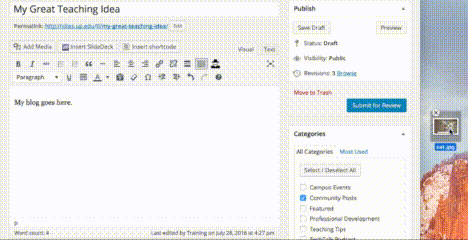This page is intended to guide students, faculty or staff who will be contributing their writing to blogs on sites.up.edu.
Log In
First, you’ll need to login. You can log in to UP WordPress here:
Once logged in you will see your WordPress profile page. To proceed to your blog, look for the My Sites link in the upper left corner. Hover over My Sites to see a dropdown that lists all the blogs you are a member of. Hover over the name of the site you want to access and click Visit Site from the flyout menu.

Make a New Post
When logged in, look for the dark toolbar along the top of the page. Click New , then select Post from the dropdown menu.

Start Writing
Now you’re ready to start writing! Make sure to give your post a descriptive title. Then go ahead and start typing your post into the main textbox (you may also type your post in Word or another program and paste the text in). Writing in WordPress is very similar to typing in any word processor. You have a toolbar that will let you bold or italicize text, create lists or block quotes, align text or images, and create hyperlinks. Clicking the toolbar toggle in the toolbar will reveal a second row of additional tools such as Header styles, underline, text color and indenting.

Multimedia
Want to add an image? Just drag and drop an image file (.jpg, .png, etc) onto the text editor to upload and insert!

Categorize and Tag
WordPress has systems to make sure posts go to the right place on the site (categories) and make posts more discoverable via search or links to related content (tags.) You can add categories and tags if you wish. Consult with the administrator or editors of your site to find out more about what categories and tags are appropriate.
Categories
In general, categories should reflect what type of content your posts is, rather than what that particular post is specifically about. You can choose a category to best fit your post such as “Teaching Tips” or “Readings”. That way your post will be grouped together with similar posts. You can choose a category to best fit your post if you wish. By default yourpost will be filed under the “uncategorized” catgory.

Tags
Tags help tell search engines what your post is all about. They also help readers find related content, even across categories. For example, I might add two separate posts – one that links to a reading on the value of mobile learning for introverts, and another that’s a teaching tip for how to use a specific mobile app to create digital stories for learning. These might be filed to different post categories but I would tag both of them with keyword such as “mobile learning”. Readers of one post interested in that topic can search or click the tag to see all posts with that tag. You can add in your own tags or check out tags that other bloggers are using to see if any of them apply to your post. There is no limit to how many tags you can apply – use as many as you think are relevant.

Publish or Submit
When you’re ready to submit your post, look in the Publish area in the upper right. Depending on your role on the sit eyou can either Publish your post or Submit for Review so the editor of your site can review and approve your post.
